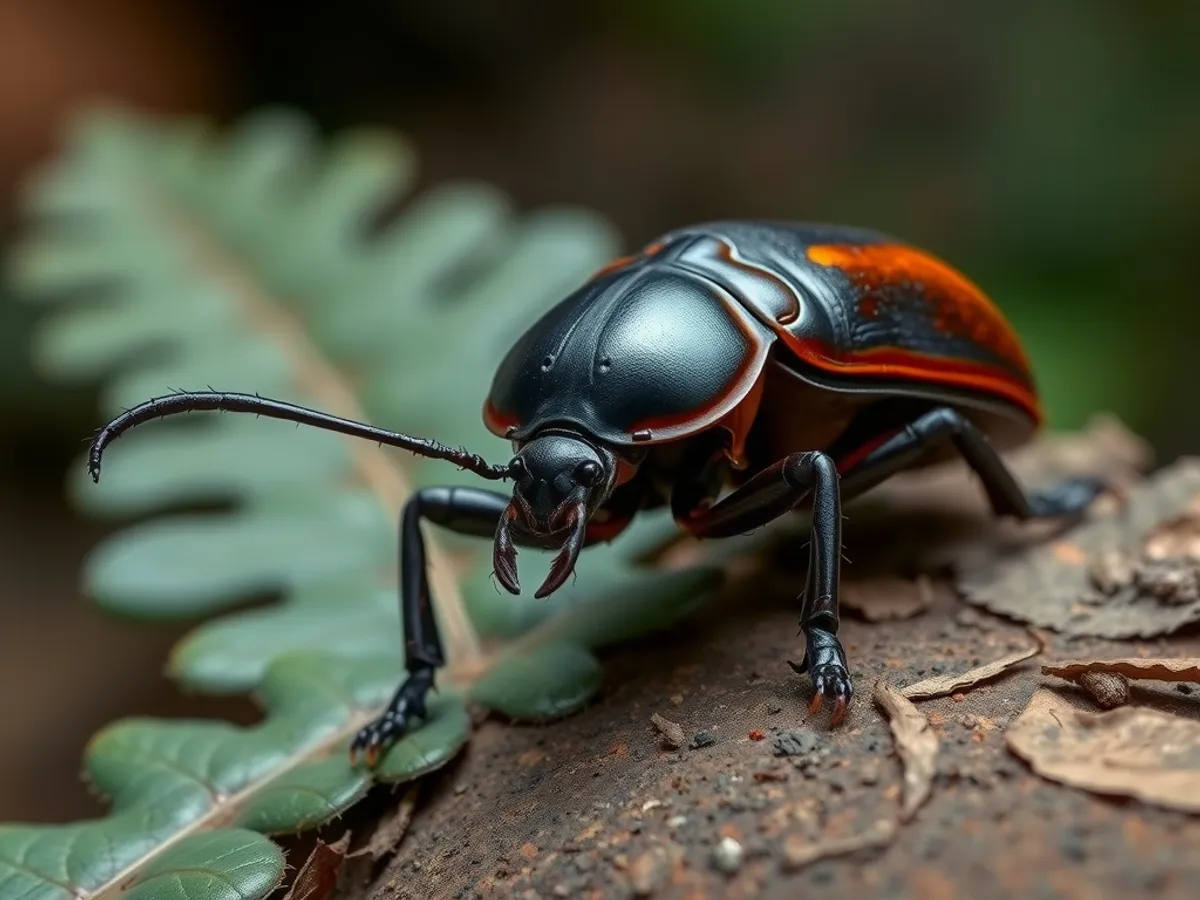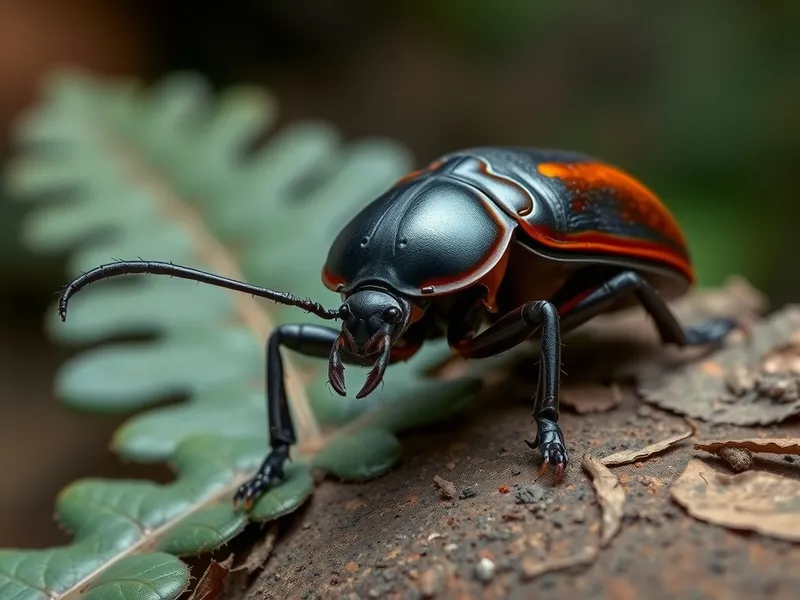
Goliath beetle
Goliathus goliatus

Meet the Goliath beetle
The Goliath beetle is one of the largest and heaviest insects on Earth, renowned for its impressive size and striking appearance. Native to the tropical forests of Africa, these beetles display a variety of color patterns, often featuring bold whites, blacks, and browns. Goliath beetles exhibit strong sexual dimorphism, with males possessing large Y-shaped horns used for combat over mates. Their larvae are equally remarkable, growing to massive sizes and feeding voraciously on decaying wood and plant matter. Adults are powerful fliers and are sometimes seen feeding on tree sap and fruit.
Classification
Invertebrate
Habitat
Tropical rainforest
Diet
Omnivore
Lifespan
6 months – 1 year
Conservation
Least Concern
Weight
50–100 grams
📖Fascinating Facts
Heavyweight Champion
Goliath beetles are among the heaviest insects, with some larvae reaching weights over 100 grams before pupating.
Forest Dwellers
They inhabit the dense tropical rainforests of Central and West Africa, depending on decaying wood and leaf litter for their larval development.
Horns for Battle
Male Goliath beetles possess prominent Y-shaped horns, which they use in fierce battles to establish dominance and win access to females.
📋Detailed Description
The Goliath beetle (Goliathus goliatus) is one of the largest and most massive insects alive, with adult males reaching lengths of 60–110 mm and females 50–80 mm. Males are distinguished by a prominent, Y-shaped cephalic horn used in intraspecific combat, especially during mating competitions. Their robust exoskeleton is adorned with striking patterns of white, black, and brown, providing both camouflage and species recognition. The elytra (wing covers) are thick and protect the delicate hindwings, which enable surprisingly strong and agile flight for such a heavy insect. Goliath beetles possess powerful legs with sharp tarsal claws adapted for climbing tree bark. Their mouthparts are specialized for lapping up sap and fruit juices, but larvae have strong mandibles for chewing decaying wood and protein-rich matter. The beetles are primarily diurnal, with adults often seen basking or feeding in the forest canopy. Goliath beetles undergo complete metamorphosis, with a larval stage that can weigh up to 100 grams, making them among the heaviest insect larvae known. Their life cycle is closely tied to the seasonal availability of food and moisture in the rainforest.
💡 Did you know?
Despite their enormous size, adult Goliath beetles are strong fliers and can cover surprising distances in search of food or mates.
🔬Research & Sources
Wikipedia Summary
The Goliath beetles are any of the six species in the genus Goliathus. Goliath beetles are among the largest insects on Earth, if measured in terms of size, bulk and weight. They are members of subfamily Cetoniinae, within the family Scarabaeidae. Goliath beetles can be found in many of Africa's tropical forests, where they feed primarily on tree sap and fruit. Little appears to be known of the larval cycle in the wild, but in captivity, Goliathus beetles have been successfully reared from egg to adult using protein-rich foods, such as commercial cat and dog food. Goliath beetles measure from 60–110 millimetres (2.4–4.3 in) for males and 50–80 millimetres (2.0–3.1 in) for females, as adults, and can reach weights of up to 80–100 grams (2.8–3.5 oz) in the larval stage, though the adults are only about half this weight. The females range from a dark chestnut brown to silky white, but the males are normally brown/white/black or black/white. Goliath beetles, while not currently evaluated on the IUCN Red List, are facing growing conservation challenges across their African range due to habitat loss, over-collection for the international pet trade, and the potential impacts of climate change.
Last Modified: 5/25/2025
🎭Behavior & Social Structure
Goliath beetles are generally solitary, except during the breeding season when males compete for access to females. Males use their horns to wrestle rivals, attempting to flip opponents off branches or logs. Adults are most active during the day (diurnal), spending much of their time feeding on tree sap, overripe fruit, and occasionally nectar. They are strong fliers, capable of traveling between trees in search of food or mates. Larvae are secretive, living within decaying logs or underground, where they feed voraciously on decomposing wood, leaf litter, and, in captivity, protein-rich foods. Adults exhibit a startle response when threatened, raising their forelegs and producing a hissing sound by rubbing body parts together (stridulation). There is little evidence of cooperative behavior, though adults may aggregate at abundant food sources.
👶Reproduction & Life Cycle
Breeding typically coincides with the onset of the rainy season, when food and humidity are optimal for larval development. Males engage in ritualized combat to secure mating opportunities, using their horns to dislodge rivals. After mating, females lay eggs in moist, decaying wood or soil. The eggs hatch after approximately 12–18 days. Larvae pass through three instars over 4–6 months, reaching lengths of up to 130 mm and weights of 80–100 grams. Pupation occurs within a self-constructed cocoon made from soil and wood fragments, lasting 3–4 months. Adults emerge at the start of the next rainy season. There is no parental care; all developmental stages are independent after oviposition.
🛡️Adaptations & Survival
Goliath beetles exhibit several adaptations for survival in dense tropical forests. Their cryptic coloration helps them blend with tree bark and foliage, reducing predation risk. The male's horn is a specialized adaptation for sexual selection, conferring an advantage in mate competition. Their strong, hooked tarsi facilitate climbing on vertical surfaces. The thick elytra protect against physical damage and desiccation. Larvae are adapted to exploit nutrient-rich decaying wood, a relatively predator-free niche. Adults' ability to digest both plant and protein-rich foods allows dietary flexibility, which is especially advantageous in fluctuating rainforest environments.
📚Research Sources
🎨Cultural Significance
Goliath beetles have long fascinated collectors and naturalists due to their impressive size and striking appearance. In some African cultures, large beetles are featured in folklore as symbols of strength or resilience. The beetles are popular in the exotic pet trade and are sometimes used in educational displays to illustrate insect diversity and adaptation. Their larvae are occasionally consumed as a protein source in local diets, though this is not widespread. The beetle's name, referencing the biblical giant Goliath, underscores its reputation as a natural wonder.
🔬Recent Research & Discoveries
Recent research has focused on the nutritional requirements of Goliath beetle larvae, revealing that high-protein diets are essential for successful development in captivity—a finding that contrasts with the primarily plant-based diets of many related scarab beetles. Studies using stable isotope analysis have begun to clarify the beetle's role in nutrient cycling within rainforest ecosystems. Ongoing genetic research is investigating the evolutionary relationships within the Goliathus genus and their divergence from other Cetoniinae. There is also growing interest in the biomechanics of their flight and horn use, with implications for understanding sexual selection and insect locomotion. Conservation biologists are calling for more field studies to assess population trends and habitat requirements.
🎥Wildlife Videos

Ultimate Fighting Champion: The Goliath Beetle | Earth Unplugged
Big thanks to James Fothergill and Dr Sean Davis at the Microscopy Unit, School of Chemistry, University of Bristol. Animal Slow ...
BBC Earth Explore

White Goliath Beetle | Wild Things with Dominic Monaghan (Season 1 Episode 3) | FULL EPISODE
Dom travels to Africa and attempts to locate one of the rarest animals on the planet—the giant white Goliath beetle. "Wild Things ...
Cream

Hercules Beetle Battle | Wild Costa Rica
#NatGeoWILD #Beetles #CostaRica About National Geographic Wild: National Geographic Wild is a place for all things animals ...
Nat Geo Animals

10 Goliath Beetle Facts - Big Beetle Hover Tank - Animal a Day
Today we learn about the large, bulky, strong, hover tank of a beetle, the Goliath Beetle. Support Animal a Day: ...
Animal a Day

Thane Maynard's Story Safari - Gretta the Goliath Beetle - Cincinnati Zoo
People are story tellers. The purpose of the zoo is to tell the story of wildlife and nature and why they are valuable to us all.
The Cincinnati Zoo & Botanical Garden

Tiny Titans - The Fascinating World of Insects | Free Documentary Nature
Tiny Titans - The Fascinating World of Insects | Wildlife Documentary Watch 'Wildlife - Just Insects' here: ...
Free Documentary - Nature
🌍Habitat Information
The Goliath beetle typically inhabits Tropical rainforest environments. Goliath beetles have adapted to their environments with specialized features and behaviors.
Primary Habitat:
Tropical rainforest
More detailed habitat information will be available soon.
🛡️Conservation Status
The Goliath beetle is currently classified as Least Concern. Conservation efforts are crucial for preserving this species for future generations.
Common Threats:
- 🏠Habitat loss and fragmentation
- 🌡️Climate change impacts
- 🎯Hunting and poaching
- 🏭Human-wildlife conflict
⚠️Threats & Conservation Challenges
While not currently evaluated by the IUCN Red List, Goliath beetles face increasing threats from habitat loss due to deforestation, agricultural expansion, and logging throughout Central and West Africa. Over-collection for the international pet and specimen trade also poses a significant risk, particularly for the most visually striking species and forms. Climate change may alter the seasonal patterns critical for their breeding and larval development. Localized population declines have been reported in areas of intense human activity, though comprehensive population data are lacking. Conservation efforts are hampered by limited ecological research and the beetle's cryptic life cycle.
🔬Scientific Classification
Scientific Name
Goliathus goliatus
Classification Hierarchy
🔍 About Taxonomic Classification
Taxonomic classification is a hierarchical system used by scientists to classify and organize living organisms based on shared characteristics and evolutionary relationships.
The system moves from broad categories (Kingdom) to increasingly specific ones, with each animal's scientific name typically consisting of its Genus and species.
📝Community Notes
Share your observations and insights about the Goliath beetle with our community of wildlife enthusiasts.
Join Our Community
Sign in to share your observations and connect with fellow wildlife enthusiasts.
Sign In to ContributeNo community notes yet
Be the first to share your observations about the Goliath beetle!
Explore Goliath beetle
Select a tab above to learn more about this amazing animal.
📸Photo Gallery
No photos available for this animal yet.
🌟Discover More Wildlife
Continue your journey of discovery with more fascinating animals from our database
